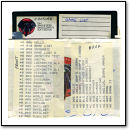Moving a Mountain (One Computer at a Time)
Friday, April 28th, 2006 On an unusually personal note for VC&G, I thought I’d let you guys know why I’ve been so quiet recently. The answer is completely on-topic and has a lot to do with what is pictured on the right: computers. You see, I’m about to move. Moving is no simple operation for anyone, but it becomes exponentially more complicated when your house is filled with over one thousand cubic feet (wild estimate, maybe more) of bulky computers, their accessories, and video game systems. I’ve not even actually started moving yet, but I’ve spent the last few weeks packing things up and getting things ready for the big haul. Phew. Next Wednesday the actual move begins, and I’m planning on renting a big truck to move as much as I can in as few loads as possible. I’ll probably take some pictures to show you later.
On an unusually personal note for VC&G, I thought I’d let you guys know why I’ve been so quiet recently. The answer is completely on-topic and has a lot to do with what is pictured on the right: computers. You see, I’m about to move. Moving is no simple operation for anyone, but it becomes exponentially more complicated when your house is filled with over one thousand cubic feet (wild estimate, maybe more) of bulky computers, their accessories, and video game systems. I’ve not even actually started moving yet, but I’ve spent the last few weeks packing things up and getting things ready for the big haul. Phew. Next Wednesday the actual move begins, and I’m planning on renting a big truck to move as much as I can in as few loads as possible. I’ll probably take some pictures to show you later.
To all our readers, and to all the people who have emailed me something that I haven’t replied to / published yet, I want to say thank you for your exceptional patience. Once I’m up and running in my new office, I’ll be pumping out new VC&G features like never before. That should be in a couple weeks at the most. I’ve got tons of cool stuff in the pipeline (including an account of my recent adventure to a local hamfest that resulted in some excellent finds), so stay tuned! Subscribe to VC&G articles via RSS and you’ll know automatically when we’re back in action.
Wish me luck on moving the mountain. If I get crushed under a PDP-11 in the process, don’t cry for me; at least I will have died moving something I loved.






 Flush from the mild success of the first article, I sat down to write the next installment of Weekend Projects for Armchair Developers. I stared blankly at the computer monitor, filled with a mild dread of what lay before me. I knew that the next programming language I had chosen would prove to be quite the thorny pickle. Browsing through the example included with the ZIP file I downloaded and thumbing through the small section in a “Retro Hacking” booklet I received last Christmas, I felt a bit overwhelmed.
Flush from the mild success of the first article, I sat down to write the next installment of Weekend Projects for Armchair Developers. I stared blankly at the computer monitor, filled with a mild dread of what lay before me. I knew that the next programming language I had chosen would prove to be quite the thorny pickle. Browsing through the example included with the ZIP file I downloaded and thumbing through the small section in a “Retro Hacking” booklet I received last Christmas, I felt a bit overwhelmed.


 There was one insurmountable obstacle between the Apple and me. At $1195 it was literally the equivalent of six months’ rent. It might as well have been a million dollars. So I looked for alternatives. I thought about building a computer. In the early 80s it wasn’t all that unusual for people to build their own computers from scratch, but it wasn’t like homebuilt computers today – you didn’t go to a computer store and buy a motherboard and CPU and case and power supply and hard drive and bolt it all together and pop in your Windows install CD. Building computers meant soldering and drilling and (sometimes) even writing your own software to make things work. When the Apple II came out in 1977 it was one of the first “store bought” computers that didn’t require any assembly. That’s one of the reasons I wanted one. As a full time student with a job and a wife I really didn’t have time to figure out how to build a computer from scratch.
There was one insurmountable obstacle between the Apple and me. At $1195 it was literally the equivalent of six months’ rent. It might as well have been a million dollars. So I looked for alternatives. I thought about building a computer. In the early 80s it wasn’t all that unusual for people to build their own computers from scratch, but it wasn’t like homebuilt computers today – you didn’t go to a computer store and buy a motherboard and CPU and case and power supply and hard drive and bolt it all together and pop in your Windows install CD. Building computers meant soldering and drilling and (sometimes) even writing your own software to make things work. When the Apple II came out in 1977 it was one of the first “store bought” computers that didn’t require any assembly. That’s one of the reasons I wanted one. As a full time student with a job and a wife I really didn’t have time to figure out how to build a computer from scratch. 




